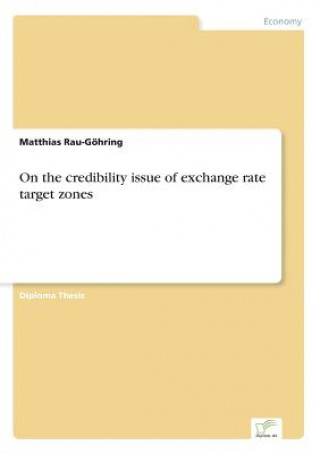
Dostawa
Doradca ds. zakupów
16 114 291 książek w 175 językach







Pokaż wszystkie języki (175)





Jednak się nie przyda? Nic nie szkodzi! U nas możesz zwrócić towar do 30 dni
 Bon prezentowy
O dowolnej wartości
Bon prezentowy
O dowolnej wartości
Bon prezentowy to zawsze dobry pomysł. Obdarowany może za bon prezentowy wybrać cokolwiek z naszej oferty.
On the credibility issue of exchange rate target zones
 Angielski
Angielski
 174 b
174 b
30 dni na zwrot towaru
Mogłoby Cię także zainteresować


Diploma Thesis from the year 1999 in the subject Economics - Macro-economics, general, grade: 2,0, University of Bonn (Wirtschaftswissenschaften), language: English, abstract: Inhaltsangabe:Zusammenfassung:§Währungskrisen, wie die des Europäischen Währungssystems (EWS) 1992, können noch immer nur unzureichend vorausgesagt werden. Es wird jedoch anerkannt, dass die Glaubwürdigkeit eines jeden Währungssystems ausschließlich endogen bestimmt wird, d.h. durch Interaktion der einzelnen Akteure an den Wechselkursmärkten. §Die vorliegende Arbeit untersucht, ob ein bestimmtes Glaubwürdigkeitsmaß, eingeführt von Avesani, Gallo und Salmon (1995), geeignet ist, die große EWS Krise 1992 vorauszusagen. Dabei handelt es sich um ein dynamisches Spiel, in dem die beiden Akteure (Zentralbank und Finanzmarkt) miteinander interagieren und damit die Glaubwürdigkeit des Systems aushandeln . Es wird gezeigt, dass o.g. Glaubwürdigkeitsmaß ein geeigneter Indikator für Währungskrisen darstellt, was empirisch anhand des französischen Francs, der italienischen Lira und des niederländischen Guldens nachgewiesen wird.§Introduction:§The objective of the present study is to present the literature of exchange rate target zones and to explore empirically the Avesani-Gallo-Salmon credibility measure for selected currencies belonging to the Exchange-Rate Mechanism (ERM) of the European Monetary System (EMS). In the past decade the empirical literature on real world target zones mushroomed considerably, but still, its overall significance in explaining strains in the relevant foreign exchange markets remains relatively low. In this context, I will explore whether the Avesani-Gallo-Salmon (1995) credibility measure demonstrates more power than earlier studies in the analysis of the 1992/3 EMS crisis.§It is not my intention to pursue a normative analysis whether flexible or fixed exchange rates or intermediate regimes are superior to one another in terms of their economic implications. This question is beyond the scope of my analysis.1 Given that target zones are applied frequently in the real world, I purely want to figure out, whether their application is sensible on grounds of a firm commitment of the policy-makers.§Exchange rate bands have been discussed widely after the breakdown of the Bretton Woods System in 1973. Although experiences with the fixed exchange rate regime were disappointing in the 1960s, increased volatility and/or overshooting of the exchange rates in the 1970s let economists doubt the famous argument by Friedman (1953) that speculation would stabilize exchange rate movements in the floating system. McKinnon (1976) reckoned that there may be an insufficient amount of speculation due to institutional constraints, other economists suspected speculators to be ill-informed and therefore act in an irrational manner. However, the desire to avoid speculative pressure and crises within the foreign exchange market resulted in the IMF s Guidelines for Floating, which entailed the possibility that a country brings its exchange rate within, or closer to, some target zone of rates (see IMF (1974, p.181). In 1979 the European Monetary System was established and -although different in design- subsequently some Latin American, Scandinavian and South-East Asian countries set up unilateral target zones for their exchange rates, too. With the Plaza Communiqué of the G-5 countries in 1985 and its successor, the Louvre Accord of 1987, also the major industrial countries returned to manage their exchange rates rather than either fix or float them. Exchange-rate target zones (target zones from now on) were seen as a sensible third way of exchange rate management. They are defined by a central parity for the exchange rate and a fluctuation band around this parity.§The first comprehensive target zone proposal was made by Williamson (1983). He presented a model that subsumes the following featu...
Informacje o książce
 Angielski
Angielski
Kategoria




 Jak kupować
Jak kupować


















